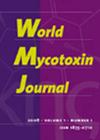基于抗体共轭磁性纳米颗粒的比色法检测和定量小麦籽粒中黄曲霉毒素B1
IF 1.7
4区 医学
Q3 FOOD SCIENCE & TECHNOLOGY
引用次数: 1
摘要
黄曲霉毒素B1(AFB1)是黄曲霉产生的致癌作用最强的次生代谢产物。作为一个食品安全问题,开发一种快速、经济、灵敏、易用的黄曲霉毒素检测方法是首要要求。在本研究中,将AFB1与牛血清白蛋白(BSA)偶联,并通过HPLC纯化AFB1-BSA偶联物。通过UV-Vis光谱、FTIR和MALDI-TOF质谱证实了纯化。在兔体内制备了抗AFB1-BSA偶联物的多克隆抗体,并用A蛋白-琼脂糖和BSA-琼脂糖亲和柱纯化。采用共沉淀法合成了氧化铁纳米粒子(MNPs),并用(3-氨基丙基)三乙氧基硅烷(APTES)对其表面进行了功能化处理。通过电子显微镜测定APTES缀合的MNP的大小,并通过几种生物物理技术进行表征。将纯化的抗AFB1抗体与表面官能化的MNP缀合,并且通过通过场发射扫描电子显微镜测定游离的和抗体缀合的MNP的尺寸来确认缀合,其中由于抗体缀合而观察到颗粒尺寸从10-20nm增加到40-50nm。抗AFB1抗体偶联的MNPs用于从添加黄曲霉毒素的小麦颗粒中捕获AFB1,回收率超过80%,并有效使用了五次。然后通过灵敏的比色测定法对捕获的AFB1进行定量,其中无色AFB1首先通过NaOH转化为香豆素酸。随后,香豆酸与2,6-二溴醌-4-氯酰亚胺(DBQC)反应生成绿色吲哚酚产物,该产物通过分光光度法进行定量。所开发的技术检测到小麦颗粒中的AFB1污染低至2μg/kg,表明其在饲料和食品材料中黄曲霉毒素的定性和定量分析中具有潜在的应用前景。本文章由计算机程序翻译,如有差异,请以英文原文为准。
Antibody conjugated magnetic nanoparticle based colorimetric assay for the detection and quantification of aflatoxin B1 in wheat grains
Aflatoxin B1 (AFB1) is a most potent carcinogenic secondary metabolite produced by Aspergillus flavus. As a food safety concern, development of a rapid, cost effective, sensitive and easy to use method for the detection of aflatoxin is of prime requirement. In this study, AFB1 was conjugated with bovine serum albumin (BSA), and AFB1-BSA conjugate was purified by HPLC. Purification was confirmed by UV-Vis spectroscopy, FTIR and MALDI-TOF mass spectrometry. The polyclonal antibody was raised against AFB1-BSA conjugate in rabbit and purified by protein A sepharose and BSA sepharose affinity columns. Iron oxide nanoparticles (MNPs) were synthesised by co-precipitation method and their surface was functionalised with (3-aminopropyl) triethoxysilane (APTES). Size of APTES conjugated MNPs was determined by electron microscopy, and characterised by several biophysical techniques. The purified anti-AFB1 antibody was conjugated with surface functionalised MNPs and the conjugation was confirmed by determining the sizes of free and antibody conjugated MNPs by field emission scanning electron microscope where increase of particle sizes from 10-20 to 40-50 nm was observed due to antibody conjugation. Anti-AFB1 antibody conjugated MNPs were used for capturing AFB1 from the aflatoxin spiked wheat grains with a recovery percentage of more than 80% and used effectively five times. The captured AFB1 was then quantified by a sensitive colorimetric assay where colourless AFB1 was first converted into coumaric acid by NaOH. Subsequently, coumaric acid reacted with 2,6-dibromoquinone-4-chloroimide (DBQC) to a green-coloured indophenol product which was quantified spectrophotometrically. AFB1 contamination as low as 2 μg/kg in wheat grains was detected by the developed technique suggesting its potential application for both qualitative and quantitative analysis of aflatoxins present in feed and food materials.
求助全文
通过发布文献求助,成功后即可免费获取论文全文。
去求助
来源期刊

World Mycotoxin Journal
MYCOLOGY-
CiteScore
4.60
自引率
5.00%
发文量
25
审稿时长
>12 weeks
期刊介绍:
''World Mycotoxin Journal'' is a peer-reviewed scientific journal with only one specific area of focus: the promotion of the science of mycotoxins. The journal contains original research papers and critical reviews in all areas dealing with mycotoxins, together with opinions, a calendar of forthcoming mycotoxin-related events and book reviews. The journal takes a multidisciplinary approach, and it focuses on a broad spectrum of issues, including toxicology, risk assessment, worldwide occurrence, modelling and prediction of toxin formation, genomics, molecular biology for control of mycotoxigenic fungi, pre-and post-harvest prevention and control, sampling, analytical methodology and quality assurance, food technology, economics and regulatory issues. ''World Mycotoxin Journal'' is intended to serve the needs of researchers and professionals from the scientific community and industry, as well as of policy makers and regulators.
 求助内容:
求助内容: 应助结果提醒方式:
应助结果提醒方式:


